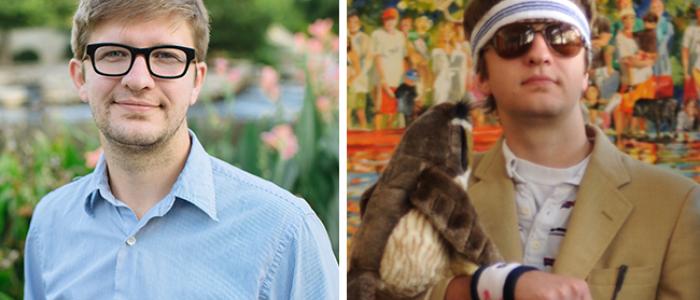The Dogrun
a place to share ideas
I’ve learned a lot from Rand the last 4 years here at Lake | Flato. At the surface, you’d think that he’s just really interested in architecture, but it’s more – he’s an adventurer and inspiration junkie, searching for truth. It’s hard to have a conversation with him and not get psyched about a new idea, concept, trip, etc… a beer after work with Rand was usually the opposite of unwinding – conversations often aimed towards gearing up – there’s good work to be done, to see, to learn from, and we have to be ready. This attitude dissipates pretty easily when in the daily grind. So with that – I...
Sunday, May 31st, the historically appreciative "Nerd Train" took an impromptu trip south down the river. LFer's Ben Hartigan, Ty Reece and myself eventually biked all the way down Mission Reach, stopping at Mission San Juan and finally Mission Espada. The weather had cooled and droves of people were all along the river enjoying their Sunday afternoon. Mission San Juan is the 4th mission along the river (starting from the Alamo and going south) and was founded in the early 1700's. It is smaller in scale than Mission San Jose (visited by the Nerd Train last summer http://www.lakeflatodogrun...
What better way to start off a Friday than with waffles, polka music and reducing our carbon emissions? Our first Bike4Breakfast of the year was a success with the seasonal appearance of the always popular nectarine! Why is bicycle commuting so important? Here is a quick comparison of building energy to commuting energy: • The typical office building uses 80kBtu/sf/yr (Ours uses 100kBtu/sf/yr), and office buildings usually work out to 1 employee per 300sf (ours is 125sf). Here we use about 12,500 kBtu/employee/yr. If we were to make our office 50% more efficient, we would save ~6,000 kBtu/...
Sunnie always shines bright. Whether she offers a cheerful good morning or late in the evening tells you goodnight after a busy day at the office, her energy and cheerful personality always shines through. My little Cajun sister Sunnie. I’m not sure if her parents saw it at birth or if they did it like some Indian tribes and waited to see her personality develop before naming her – however they arrived at her name: they nailed it. From the first day I met Sunnie at lunch during her interview, I realized her name matched her personality perfectly. In the short time Sunnie has been in our...
As an architect, I have an appreciation for the role that climate, culture, and landscape play in the making of cities, and, through this lens, I enjoy discovering what makes places special. David Heymann , an architect and professor at the University of Texas, in his short but well written My Beautiful City Austin , leverages this unique architectural perspective to deliver a nice portrait of the city. In his contemporary fictional narrative, told through the eyes of a thoughtful young residential architect who is trying desperately to “do the right thing” in the rapidly sprawling and...
Of the 20 imperatives of the Living Building Challenge, the two that we found to be most difficult were Red List and Appropriate Sourcing. Following up on our recent publication of the material matrix for the Josey Pavilion , here’s a look at how we tackled these two challenges. Imperative 11: Red List The Red List contains 13 chemicals that should not exist in the built environment and are not permitted anywhere in a living building. Some chemicals on the list, Chlorofluorocarbons (CFCs) and asbestos, were easy to avoid as they have been phased out of the material economy through regulation...
Katie Cavazos recently became part of our Lake|Flato family after trading the windy city of Chicago, Illinois for the recently rainy city of San Antonio, Texas. Katie attended Illinois Institute of Technology, where she earned a Bachelor of Architecture and Minor in Landscape Architecture. With that combination, it is no wonder that Government Canyon Visitor Center is her favorite Lake|Flato project. Since her arrival at LF, Katie has been working on the design for the Biomedical Sciences and Engineering Education Building at the Universities at Shady Grove campus in Rockville, Maryland. For...
The San Antonio River Foundation Confluence Park provides a unique opportunity to celebrate the ecology of the South Texas region, demonstrate the value of our natural resources, and foster environmental stewardship in a traditionally underserved area adjoining the San Antonio River. With education as its core purpose, Confluence can be understood as an intricate teaching tool that will inspire people to become more involved with the river, practice environmental stewardship, and gain a greater understanding of Texas ecotypes. At every corner, visitors will find an opportunity to learn...
Do you know what materials make up the building you’re currently occupying? Are these materials safe? In our foray into pursuing the Living Building Challenge (LBC) for the Dixon Water Foundation Josey Pavilion, we gained new insight into building materials and their impact on human health and the environment. We are excited make our material matrix public and share what we have learned. LBC, the most advanced sustainable building certification program, is built on the philosophy that every act of design and construction should make the world a better place. An LBC-Certified building is...
As part of our goal to monitor energy use in every Lake | Flato project, we've outfitted another house with its own eMonitor. These monitors test our ability to design energy efficient buildings, allow clients to control their energy consumption and give us the information we need to improve our practice. Throughout the design process we chose passive systems, insulation, glazing, lighting and HVAC systems using energy modelling software to predict energy use. The performance of our projects is tested during post-occupancy; eMonitors provide us with up-to-the-minute data from every circuit in...
Pages














